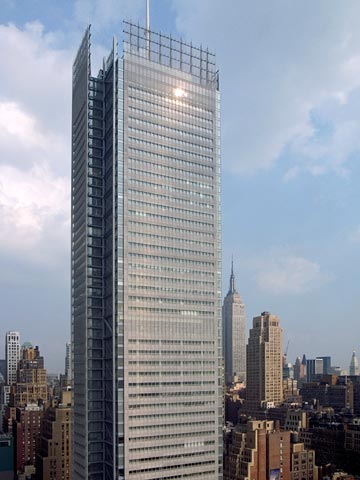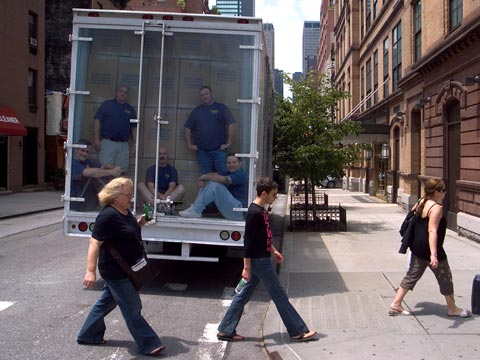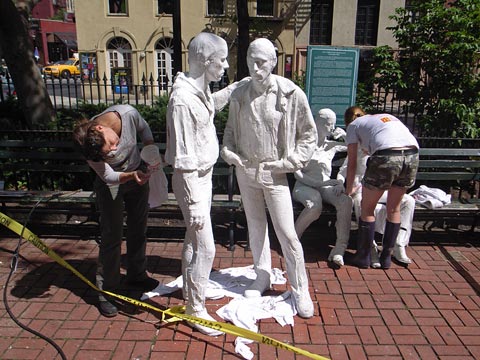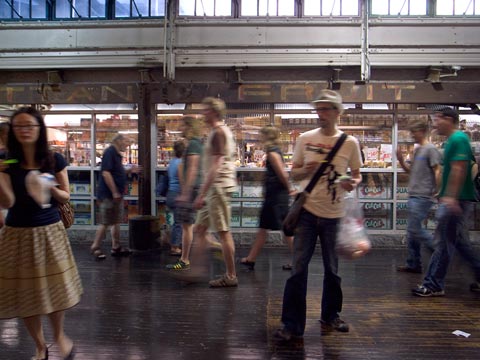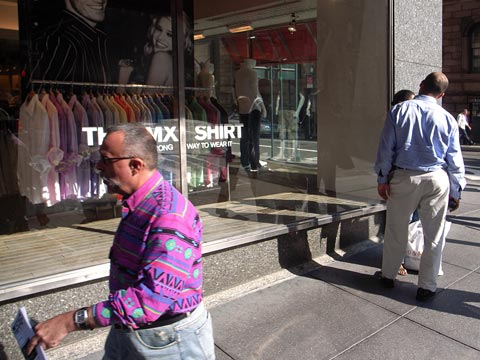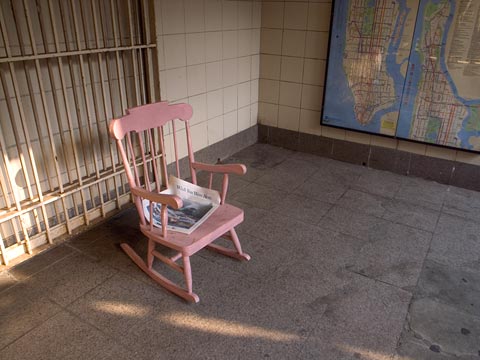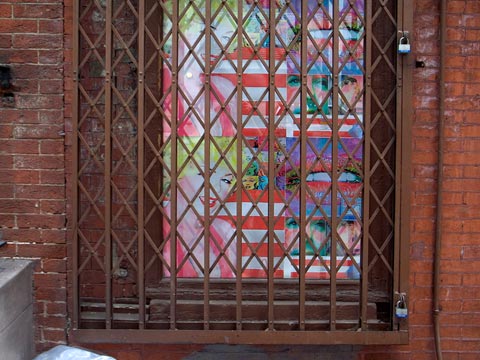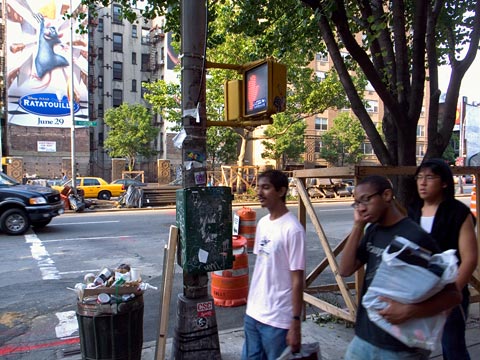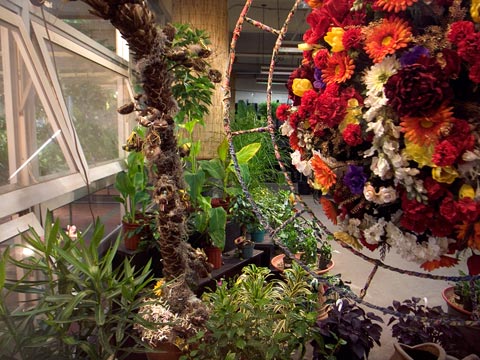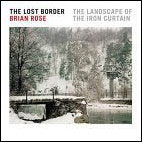Saturday, June 30, 2007
Thursday, June 28, 2007
Tuesday, June 26, 2007
New York/Prospect Heights

Grant Gore between Bedford and Rogers Avenues
I am continuing photographing Civil War statues and monuments around Brooklyn for an exhibit at the Brooklyn Public Library in the fall. Yesterday, I went with my assistant Chris Gallagher to Prospect Heights where there is a large equestrian statue of Ulysses S. Grant. It's a neighborhood that must have once seemed appropriate for such an imposing monument. The area obviously fell into decline during the '60s and '60s, but it appears to be coming back today. It's a largely Black neighborhood, contiguous with Bedford Stuyvesant and Crown Heights. There are beautiful brownstones on the side streets, some well-maintained, others not. To the east along Dean Street, where we walked, there is an industrial pocket with a mixture of uses including artists' lofts.
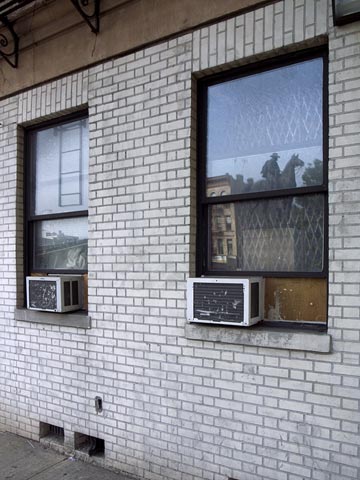
Bedford and Rogers Avenues

General Edward Fowler, Fulton Street in Fort Greene
Regarding my photographs of statues, I would like to state up front that I hope to avoid any comparison with Lee Friedlander who owns the subject as far as I am concerned. Unlike Friedlander, I am working with a view camera in color (the photos above are with my digital point-and-shoot), and I am attempting to locate these hidden-in-plain-site statues in their habitats. Brooklyn remains a vast unknown landscape to me, but I am gradually learning the geography.
New York/Bernd Becher
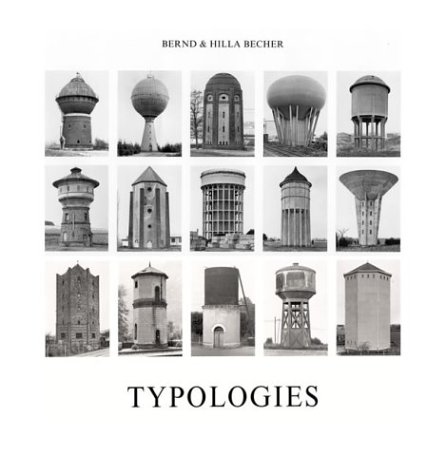
Bernd Becher has died at the age of 75. Bernd and Hilla Becher photographed the vestiges of the industrial landscape. They worked systematically in a way that aligned them with conceptual art, but they did it with a relentless, if not passionate, attention to the structures that interested them, both humble and extraordinary. They were almost as well known for the students they taught as for their work: Andreas Gursky, Candida Hofer, Thomas Ruff and Thomas Struth, among others. But the Becher's work influenced us all.
Saturday, June 23, 2007
Thursday, June 21, 2007
New York/Sixth Avenue
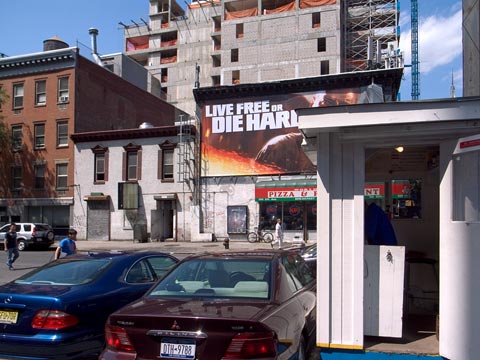
West 17th and Sixth Avenue
I spend a great deal of time in the so-called Flatiron district of New York. It's the area roughly below the Flatiron Building on 23rd street on down to 14th, home to lots of photographers and attendant services. It was even called the Photo District for a while, but now a plethora of creative industries have filled the big loft buildings on Fifth and Sixth Avenues. People live here, too. And the vacant lots are quickly filling with new apartment buildings.
Today, I a was there for one of the 39 buildings I have been assigned to shoot. It was a lovely day in New York.
Tuesday, June 19, 2007
Sunday, June 17, 2007
New York/Upper East Side

Roosevelt Island Tram, 59th Street
I have an assignment photographing 39 buildings around Manhattan. Spent most of the day in 90 degree heat schlepping around the Upper East Side scouting the buildings. As I walked down First Avenue under the Roosevelt Island tram station at the foot of the 59th Street Bridge I looked up as a cable car lifted skyward.
Saturday, June 16, 2007
New York/Public Theater
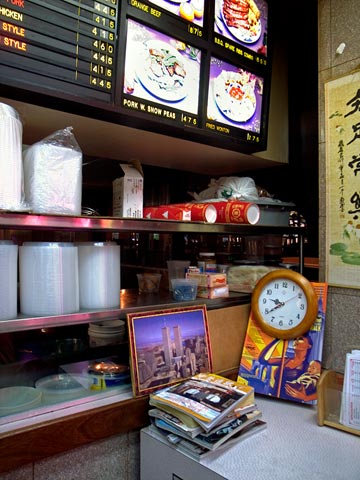
Chinese take-out on Christopher Street
Last night we went to the Public Theater to see Voices in Conflict, a play created and performed by the drama class of Wilton High School in Wilton, Connecticut. Voices is a dramatic compilation of the words of American soldiers in Iraq and Iraqi civilians. See earlier post here.
The students' production was banned from the school by principal Timothy Canty because, presumably, it was biased and controversial. But that was only the beginning of a story that eventually led to a triumphant performance of the play at the Public Theater, the pre-eminent Off Broadway showcase in New York. That triumph is muted, however, by several things. Bonnie Dickinson's job as the drama teacher at Wilton remains in danger, and–the larger issue–freedom of expression in America's schools is increasingly under threat.
Voices in Conflict began as a drama class production, but over the months as interest in the press gathered steam, the play evolved into a much more serious and well crafted project. By the time it reached the Public–after several performances in Connecticut and New York– it transcended its high school origins and became a lightening rod for those seeking a dialogue concerning the war. A number of Iraqi veterans were in the audience last night, and participated in the discussion that took place after the play ended. They, at least those present, were supportive of the students' efforts. Also participating were Chris Durang, the playwright/actor, and Martin Garbus, the prominent First Amendment lawyer.
Unfortunately, the discussion that took place last night in New York has not been allowed to occur in Wilton High. The great dichotomy of the present is that while polls show a clear majority of Americans oppose further involvement in Iraq, those who question the war often find their patriotism impugned. What we saw last night was a demonstration of what patriotism is all about.
http://www.voicesinconflict.com
Update: Bonnie Dickinson, the drama teacher at Wilton High, has been cleared of all complaint charges. (June 21, 2007)
Wednesday, June 13, 2007
New York/Grand Army Plaza
A few months ago I wrote about photographing Civil War monuments around Brooklyn for an exhibition in the fall. Well, it's finally happening, and I've gotten out several times with my view camera to take pictures. If all goes well, my photographs will comprise a unified series of contemporary views of Brooklyn monuments, which will be juxtaposed against historical materials in an exhibition at the Brooklyn Public Library.
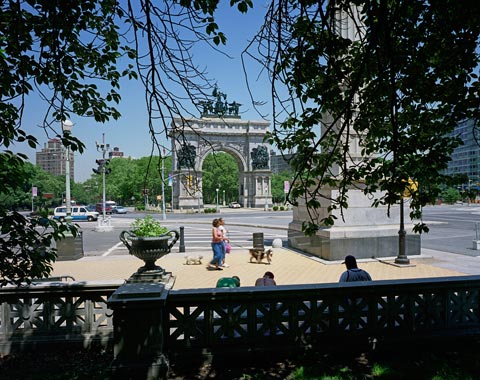
Grand Army Plaza (4x5 film)
The most important Civil War monument site in Brooklyn is Grand Army Plaza, which includes the Soldiers and Sailors Memorial Arch and adjacent statues. The arch was designed by John Duncan, and the main sculptural groupings were done by Frederick MacMonnies. MacMonnies did the wonderful Nathan Hale statue now standing in front of City Hall. Go here for my photograph of it.

Grand Army Plaza from Prospect Park (4x5 film)
Grand Army Plaza is something of a mess today–Parisian Etoile it is not. The arch, though quite massive, can't compete with the 12 lanes of traffic roaring around it. Pedestrians will find few crosswalks to the central oval island, so people routinely risk life and limb dashing across the acres of pavement. I did numerous pictures of the arch, from near and far, but am most satisfied with a couple of views from just within Prospect Park. In one, I stacked several monuments in a row: a sculpture of James S.T. Stranahan, the founder of Prospect Park, one of the four eagle-topped columns, and the arch.

Grand Army Plaza (4x5 film)
The most important Civil War monument site in Brooklyn is Grand Army Plaza, which includes the Soldiers and Sailors Memorial Arch and adjacent statues. The arch was designed by John Duncan, and the main sculptural groupings were done by Frederick MacMonnies. MacMonnies did the wonderful Nathan Hale statue now standing in front of City Hall. Go here for my photograph of it.

Grand Army Plaza from Prospect Park (4x5 film)
Grand Army Plaza is something of a mess today–Parisian Etoile it is not. The arch, though quite massive, can't compete with the 12 lanes of traffic roaring around it. Pedestrians will find few crosswalks to the central oval island, so people routinely risk life and limb dashing across the acres of pavement. I did numerous pictures of the arch, from near and far, but am most satisfied with a couple of views from just within Prospect Park. In one, I stacked several monuments in a row: a sculpture of James S.T. Stranahan, the founder of Prospect Park, one of the four eagle-topped columns, and the arch.
Monday, June 11, 2007
Friday, June 08, 2007
Thursday, June 07, 2007
New York/The Bronx

Third Avenue, the Bronx
Traveled up to the South Bronx to take a few photos for a column my wife (Renée Schoonbeek) writes for a Dutch planning magazine. She is interested in a new housing development to be built on a vacant piece of land near the Hub (Google map), a busy shopping area that has seen better days, but is obviously on the way back up. Lots of sneaker shops and fast food, but a new stretch of stores featuring national brands on Third Avenue as well. The proposed housing, designed by Grimshaw Architects, was the result of a design competition–common in Europe, but still an unusual way of working in New York.
Just a block or two away from the Hub things can get pretty desolate, though there are lots of low rise townhouses of recent vintage, and almost none of the abandonment that characterized the South Bronx in the '70s and '80s. I photographed the vacant development site, but we decided to go with the picture above to give a sense of the local street scene.
Wednesday, June 06, 2007
Monday, June 04, 2007
New York/Richard Serra
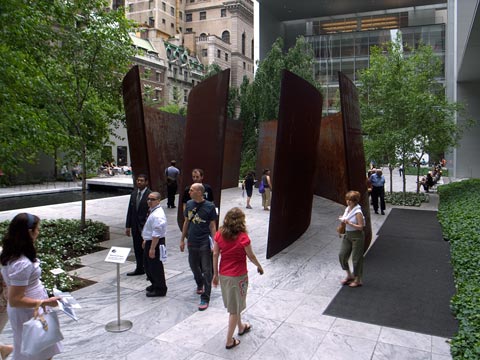
Intersection II • Richard Serra
A while ago I posted a comment about a series of photographs of Richard Serra's sculpture made by Hiroshi Sugimoto. I objected to the fuzzy treatment–Sugimoto's trademark–for this quintessentially hard-edged work. Here are a few of my images of two Serra pieces in the Museum of Modern Art garden, not offered as a rebuke to Sugimoto, but rather as quick takes while visiting with my son Brendan who streaked around the Serra arcs, a red blur.
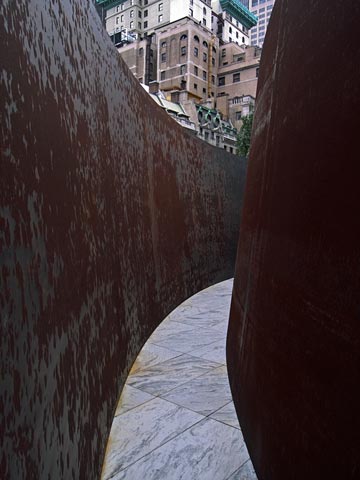
Intersection II • Richard Serra
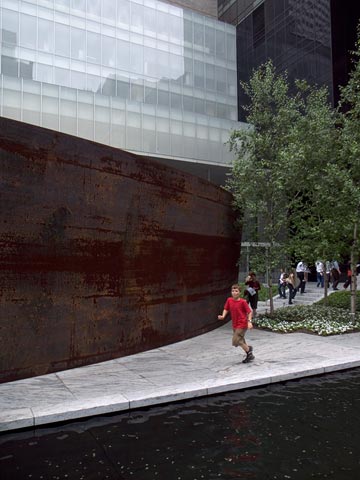
Brendan, my son, intersecting with Intersection II
I have long regarded Serra as one of the giants of contemporary art, and I was eager to see the new installation of his work at the museum. I have seen Serra in various locations: the Dia Beacon and in Chelsea, and in many outdoor settings. Like any sculpture, but particularly with Serra's, the work is dramatically changed by the context. Indoors, there is often a sense of great compression, the coiled quality of the steel seemingly ready to burst the confines of the surrounding walls. Outdoors, that tension is relaxed somewhat, the scale changed, although it depends on the siting. A willfully confrontational installation at the Federal Building in Lower Manhattan so irked the government workers who had to circumnavigate the piece that it was eventually dismantled. On the other hand, one of my favorite sitings was also in Lower Manhattan–St. John's Rotary Arc was placed within the huge roundabout formed by the Holland Tunnel exit.
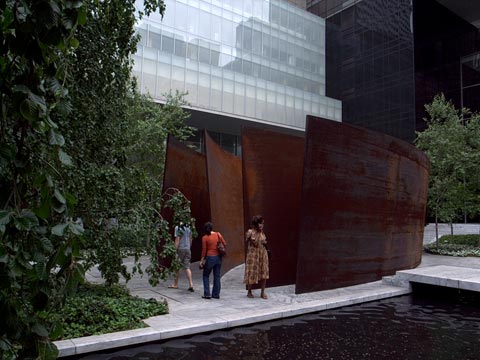
Intersection II • Richard Serra
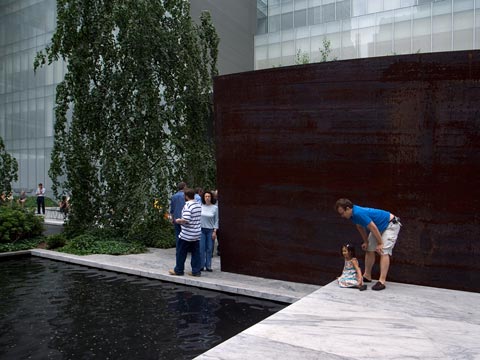
Intersection II • Richard Serra
At MoMA the two pieces on view in the sculpture garden work beautifully–on the one hand held in check by the relatively close quarters of the space–on the other hand free to the sky and juxtaposed against the gray-green trees and silver-black glass of the museum facade. Upstairs on the second floor, the completely neutral gallery spaces seemed less successful to me. Although the sculptures are impressively contained within walls, the warmish interior light and blank wall surfaces allow for less dialogue with the taut forms within. But by all means go and see–and interact.
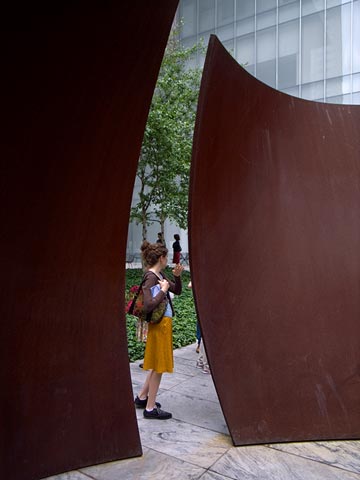
Torqued Ellipse IV • Richard Serra
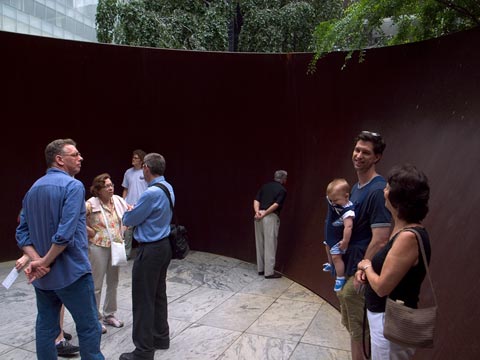
Torqued Ellipse IV • Richard Serra
MoMA has recently been presenting wonderful virtual exhibits on their website. Some of the best stuff I've seen. Here is the Serra web presentation. I did not, by the way, get a chance to see the sixth floor galleries, but will do so next time.
Sunday, June 03, 2007
New York/Grand Army Plaza
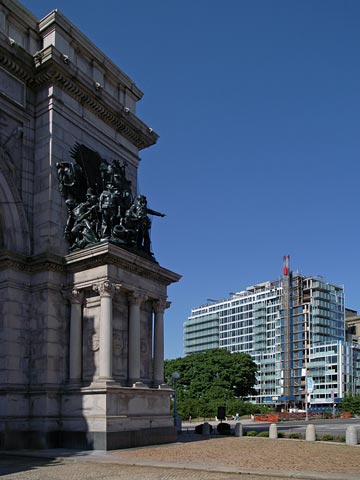
Grand Army Plaza, Brooklyn
As I wrote in an earlier post, I have been asked to make photographs of Civil War memorials around Brooklyn for an exhibit this fall at the Brooklyn Public Library. I just got started this past week with a series of pictures of several monuments and statues at Grand Army Plaza. Grand Army Plaza is marked most prominently by an arch based on the Arc de Triomphe in Paris and topped by a quadriga, not unlike the Brandenburg Gate in Berlin. I will comment some more when I have scans of the 4x5 film I shot. I did take a few pictures with my small camera including the view above of the arch and an apartment building designed by Richard Meier under construction nearby.
